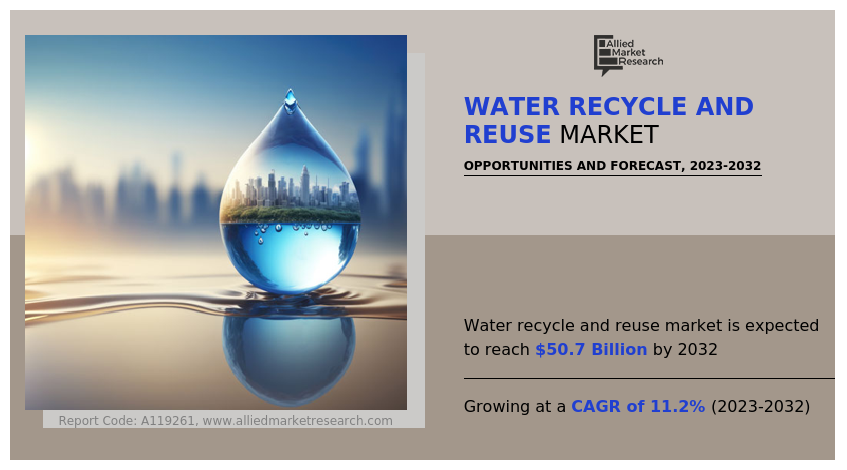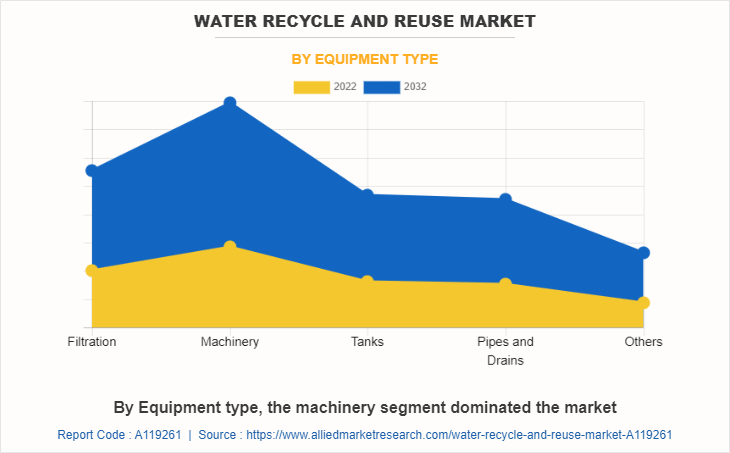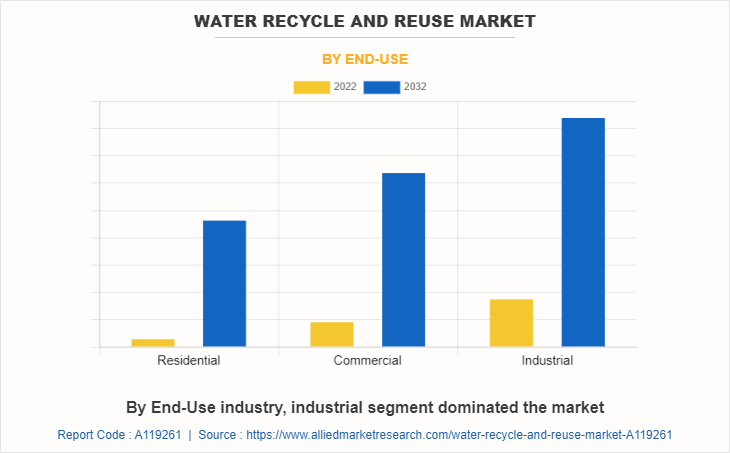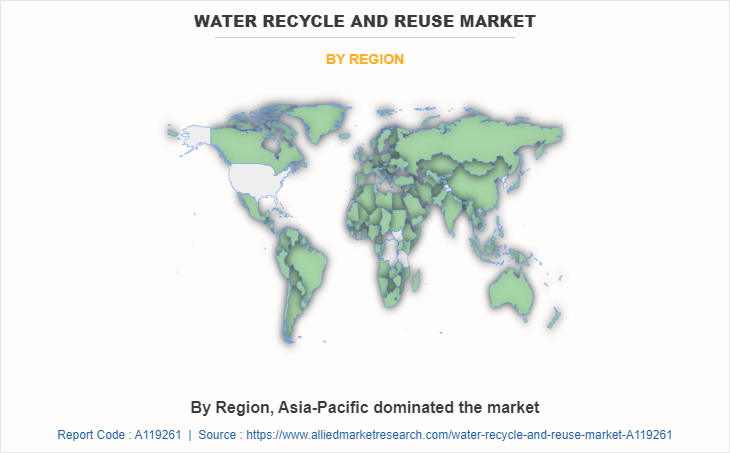Water Recycle And Reuse Market Research, 2032
The global water recycle and reuse market was valued at $17.8 billion in 2022, and is projected to reach $50.7 billion by 2032, growing at a CAGR of 11.2% from 2023 to 2032.
Report Key Highlighters:
- The water recycle and reuse market analysis of 20 countries. The research includes a segment analysis of each country in terms of both value ($million) for the projected period 2023-2032.
- The study integrated high-quality data, professional opinions and analysis, and critical independent perspectives. The research approach is intended to provide a balanced view of global markets and to assist stakeholders in making educated decisions in order to achieve their most ambitious growth objectives.
- Over 3,700 product literatures, annual reports, industry statements, and other comparable materials from major industry participants were reviewed to gain a better understanding of the market.
- The water recycle and reuse industry is highly fragmented, with several players including Alfa Laval AB, Aquatech International LLC, Aquatherm Water Treatment, Aries Chemical Inc., DeLoach Industries Inc., Ecolab Inc., Element Solutions Inc., Evoqua Water Technologies LLC, Industrial Water Equipment Ltd, and Hitachi Ltd. Also tracked key strategies such as acquisitions, product launches, mergers, expansion etc. of the players operating in the water recycle and reuse market.

Water recycling and reuse is the process of treating and repurposing wastewater or used water for various purposes instead of discarding it. It involves the collection and treatment of wastewater to eliminate impurities and make it suitable for specific applications such as non-potable and potable uses. This involves multiple stages such as collection, treatment, disinfection, and distribution. Advanced technologies like membrane filtration, reverse osmosis, and disinfection are employed to ensure the removal of contaminants and maintain the safety and quality of the reclaimed water. Water recycling and reuse offer several advantages, such as conserving water, reducing freshwater demand, promoting sustainability, protecting the environment, and potentially saving costs.
Water recycling and reuse have diverse applications across various sectors. In agriculture, recycled water is used for irrigation, reducing the reliance on freshwater sources and supporting sustainable crop production. In urban areas, recycled water is utilized for landscape irrigation, parks, and recreational purposes, ensuring green spaces thrive even during water scarcity periods. Industrial processes benefit from water reuse, as treated wastewater is used for cooling, manufacturing, and other non-potable applications.
Water recycle and reuse, also known as water reclamation or water reutilization, refers to the process of treating and reusing wastewater or reclaimed water for various purposes instead of discarding it as waste. This process involves treating wastewater to remove contaminants and pollutants to make it safe for reuse. The treated water can be employed for various non-potable applications, such as irrigation, industrial processes, groundwater recharge, and even for potable use with advanced treatment technologies.
Industries consume vast amounts of water for various processes. water recycle and reuse offer substantial benefits to industrial operations by reducing the reliance on freshwater sources and minimizing wastewater discharge. Reclaimed water can be used for cooling towers, equipment cleaning, and manufacturing processes, among others. Additionally, by reusing water, industries can significantly reduce their environmental footprint and lower water-related costs.
The growing global population increases the water demand and leads to water scarcity which boosted the demand for water recycling and reuse.
Water recycling and reuse play a crucial role in minimizing pollution and environmental impact by reducing the discharge of treated wastewater into water bodies. This helps protect aquatic ecosystems and ensure water availability for various uses. In addition, other factors such as climate change, unequal distribution of water resources, unsustainable water management practices, urbanization & industrialization, pollution & water contamination, and inadequate water infrastructure increase demand for the water recycle and reuse market.
There are several benefits associated with water recycling and reuse. It helps meet the rising water demand by providing an additional source of water supply. It also reduces the pressure on existing freshwater sources, preserving them for essential uses such as drinking and agriculture. Additionally, recycling and reusing water can contribute to the conservation of energy and the reduction of pollution. It can also help mitigate the impact of droughts and climate change on water availability.
Public awareness and acceptance with respect to water recycle and reuse.
Increasing public awareness about water scarcity, pollution, and the importance of sustainable water management has led to greater acceptance and support for water recycling and reuse initiatives. Public demand for environmentally friendly practices encourages businesses and governments to invest in water recycling infrastructure.
Consumers are increasingly demanding environmentally friendly products and services across various sectors, including water management. This demand creates market opportunities for businesses and encourages them to invest in water recycling infrastructure to meet consumer expectations and gain a competitive advantage.
The water recycling and reuse market is segmented on the basis of equipment type, end-use industry, and region. By equipment type, the market is segmented into filtration, machinery, tanks, pipes & drains, and others. The end-use industry covered in the report includes residential, commercial, and industrial. By region, the market is analyzed across North America, Europe, Asia-Pacific, and LAMEA.

Water recycling and reuse in machinery refers to the practice of treating and reusing water within industrial processes or equipment instead of consuming freshwater resources. This approach helps to conserve water, reduce costs, and minimize the environmental impact associated with water consumption and wastewater disposal.
Machinery often requires cooling to prevent overheating. Water is commonly used as a cooling medium in processes such as power generation, manufacturing, and HVAC systems. By implementing closed-loop cooling systems, water can be continuously circulated and treated to maintain its quality, reducing the need for freshwater intake. Implementing water treatment technologies, such as filtration, sedimentation, and disinfection, can enable the reuse of process water, reducing the demand for fresh water and minimizing wastewater generation.

Many industrial processes require water for various purposes, such as cleaning, rinsing, dilution, and as a raw material. By treating and reusing process water, industries can reduce their dependence on freshwater sources and minimize wastewater generation.
The industrial sector is increasingly embracing the concept of the circular economy, which focuses on reducing waste and optimizing resource efficiency. In line with this approach, water recycling and reuse have gained significant attention. These practices help minimize water waste and enable industries to create a closed loop in their water consumption, thereby reducing their dependence on freshwater sources. As a result, the demand for water recycling and reuse in the industrial sector has been growing steadily.

The Asia-Pacific region has a significant industrial and agricultural sector that heavily relies on water resources. Implementation of water recycling and reuse practices in industries and agriculture contributes to water conservation, reduces dependence on freshwater sources, and improves overall water efficiency. Recycled water can be used for processes, cooling, irrigation, and aquaculture.
Recycling water allows for more efficient water use within industrial processes, cooling systems, irrigation, and aquaculture. By reusing water, industries can optimize their water consumption and reduce waste.
Water recycle and reuse market forecast competitive intelligence on prominent manufacturers of water recycle and reuse provides key insights on the strategies implemented to gain a significant share in the global water recycle and reuse market. Top market players in global water recycle and reuse are adopting product launch, partnership, and expansion as their key business strategies to sustain in the competitive market. Some of the leading manufacturers profiled in this report include Alfa Laval AB, Aquatech International LLC, Aquatherm Water Treatment, Aries Chemical Inc., DeLoach Industries Inc., Ecolab Inc., Element Solutions Inc., Evoqua Water Technologies LLC, Industrial Water Equipment Ltd, and Hitachi Ltd.
Historical trends of water recycling and reuse:
- In the 1960s-1970s the concept of water recycling and reuse began gaining attention as industries recognized the value of treating and reusing water for various processes. Initial efforts focused on industrial applications, particularly in water-intensive sectors such as power generation and manufacturing.
- In the 1980s advancements in wastewater treatment technologies such as the implementation of secondary treatment processes like activated sludge and biological nutrient removal. These processes improved the quality of treated wastewater, expanding opportunities for water reuse.
- In the 1990s, water recycling and reuse gained momentum as a viable solution for addressing water scarcity. Countries and regions started developing guidelines and regulations for water reuse, leading to increased adoption in agriculture, landscape irrigation, and non-potable urban uses.
- The 2000s is a growing emphasis on water reuse as an integral part of sustainable water management strategies. Advancements in treatment technologies, such as membrane filtration and advanced oxidation processes, enhanced the quality and reliability of reclaimed water. Large-scale water reuse projects were implemented in several regions to augment water supplies.
- 2010 marked a significant expansion of water recycling and reuse initiatives. Increasing population growth, rapid urbanization, and concerns about water scarcity and climate change further drove the adoption of water reuse practices. Large-scale water reuse projects, including indirect potable reuse, gained traction in various regions.
- In 2015, water recycling and reuse had become increasingly integrated into water resource management strategies. Stringent water regulations and standards, coupled with advancements in treatment technologies and monitoring systems, improved the safety and reliability of reclaimed water. More regions and cities embraced water reuse as a sustainable solution for water conservation and resilience.
- In the 2020s, water recycling and reuse initiatives expanded further. An increase in awareness of water scarcity, climate change impacts, and circular economy principles is driving greater adoption of water recycling and reuse practices. Technological innovations, such as advanced treatment processes and smart water management systems, are being integrated into water reuse strategies.
Key Benefits For Stakeholders
- This report provides a quantitative analysis of the market segments, current trends, estimations, and dynamics of the water recycle and reuse market size from 2022 to 2032 to identify the prevailing water recycle and reuse market opportunities.
- The market research is offered along with information related to key drivers, restraints, and opportunities.
- Porter's five forces analysis highlights the potency of buyers and suppliers to enable stakeholders make profit-oriented business decisions and strengthen their supplier-buyer network.
- In-depth analysis of the water recycle and reuse market share assists to determine the prevailing market opportunities.
- Major countries in each region are mapped according to their revenue contribution to the global water recycle and reuse market growth.
- Market player positioning facilitates benchmarking and provides a clear understanding of the present position of the market players.
- The report includes the analysis of the regional as well as global water recycle and reuse market trends, key players, market segments, application areas, and market growth strategies.
Water Recycle and Reuse Market Report Highlights
| Aspects | Details |
| Market Size By 2032 | USD 50.7 billion |
| Growth Rate | CAGR of 11.2% |
| Forecast period | 2022 - 2032 |
| Report Pages | 229 |
| By Equipment Type |
|
| By End-Use |
|
| By Region |
|
| Key Market Players | Alfa Laval AB, Evoqua Water Technologies LLC, Aquatherm Water Treatment, Element Solutions Inc., Hitachi Ltd., Ecolab Inc., Industrial Water Equipment Ltd., Aries Chemical Inc., DeLoach Industries Inc., Aquatech International LLC |
Analyst Review
According to the opinions of various CXOs of leading companies, the water recycle and reuse market is expected to witness increased demand during the forecast period. As water scarcity intensifies, there is a greater need for alternative water sources and sustainable water management practices which increase the demand for water recycle and reuse during the forecast period.
Water recycling and reuse involve treating wastewater to make it suitable for various applications instead of being wasted. The process includes collection, treatment, disinfection, and distribution. Advanced technologies like membrane filtration and reverse osmosis remove contaminants and ensure water quality. The benefits of water recycling and reuse include water conservation, reduced freshwater demand, sustainability, environmental protection, and cost savings.
The market is being driven by rising water scarcity and stress and advancement in water treatment technologies. The global population increases rapidly which increases water demand for various purposes such as drinking, agriculture, and industrial activities. Advancements in water treatment technologies have improved the efficiency and reliability of treating water, leading to better water quality and increased access to safe drinking water. These facts indicate that the water recycle and reuse market is expected to expand considerably throughout the projected period.
Alfa Laval AB, Aquatech International LLC, Aquatherm Water Treatment, Aries Chemical Inc., DeLoach Industries Inc., Ecolab Inc., Element Solutions Inc., Evoqua Water Technologies LLC, Industrial Water Equipment Ltd, and Hitachi Ltd. are the top companies to hold the market share in water recycle and reuse market.
Asia-Pacific is the largest regional market for water recycle and reuse market.
The industrial segment is the leading end-use industry of water recycle and reuse market.
Rise in population and rapid urbanization and increasing focus on industrial water reuse are the upcoming trends of water recycle and reuse market in the world.
Increase in water scarcity and stress and advancements in water treatment technologies are the driving factor of water recycle and reuse market.
Infrastructure limitations for water recycling and reuse is the challenges encountered in the market for water recycling and reuse.
The global water recycle and reuse market was valued at $17.8 billion in 2022, and is projected to reach $50.7 billion by 2032, growing at a CAGR of 11.2% from 2023 to 2032.
Loading Table Of Content...
Loading Research Methodology...



